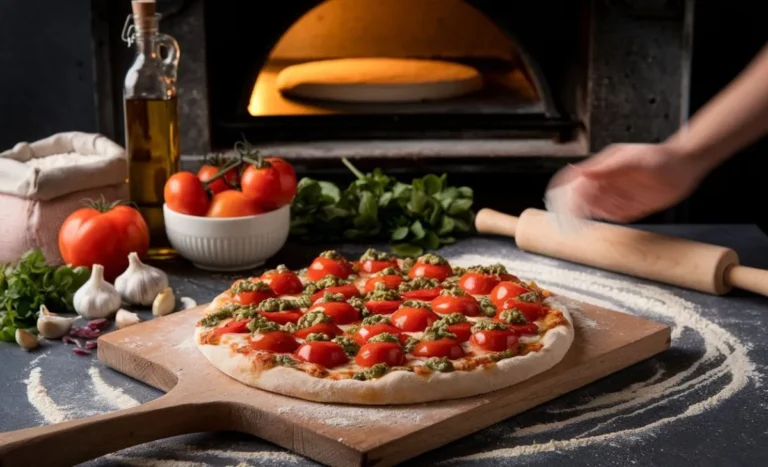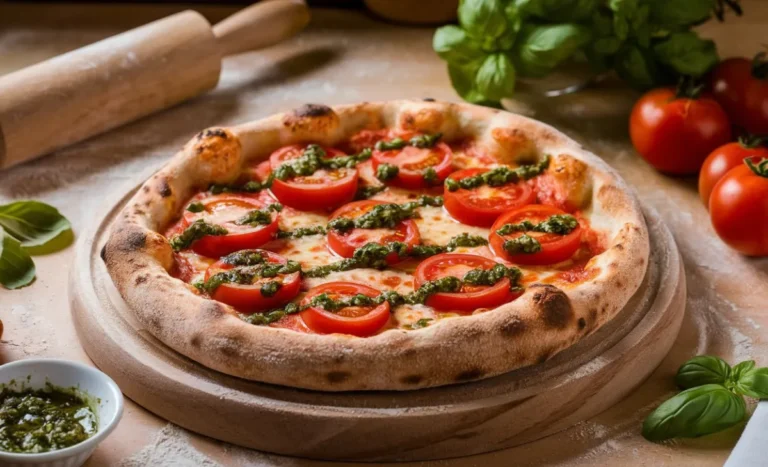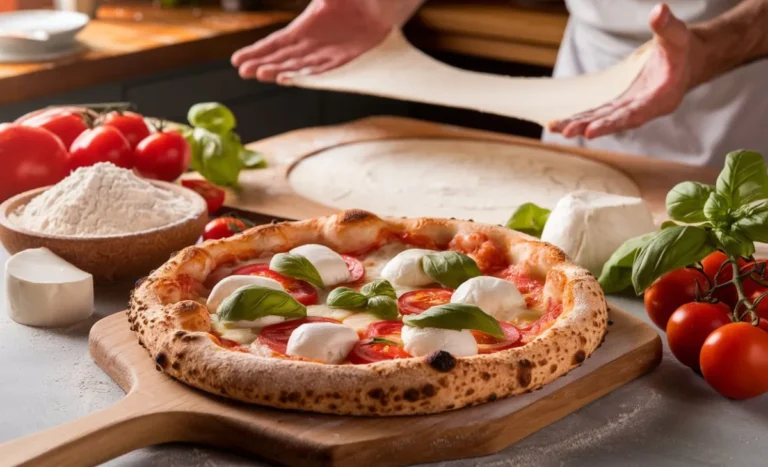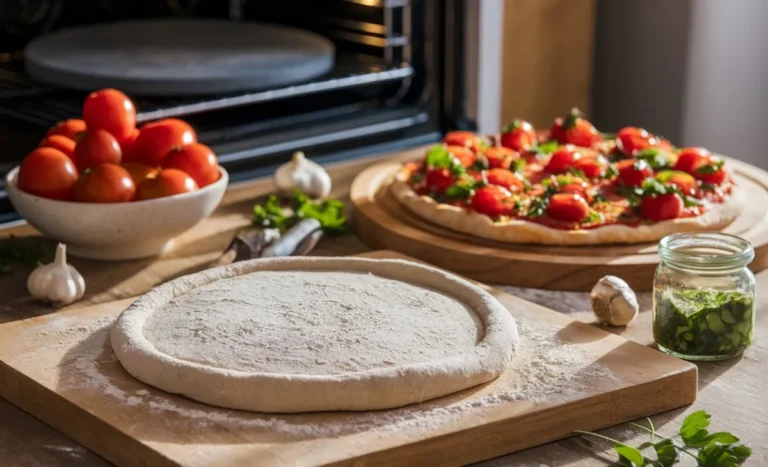How to Make Authentic Italian Pizza at Home: Understanding Pizza Flour
Introduction to Authentic Italian Pizza
Choosing the right pizza flour is crucial for achieving the authentic Italian pizza experience at home. The flour acts as the foundation of the dough, influencing its texture, flavor, and overall quality. Understanding the various types of pizza flour can help you select the best one for your homemade pizza, ensuring a delicious result with every bake.
Different pizza flours have varying protein contents, which directly impact the dough’s elasticity and chewiness. For instance, 00 flour, commonly used in Italy, has a fine texture and a moderate protein level. This combination allows for a tender yet stretchy dough, ideal for creating that characteristic thin crust. In contrast, bread flour has a higher protein content, resulting in a chewier crust that holds up well under generous toppings. Selecting the appropriate flour for your desired pizza style is essential for achieving the right balance.
In addition to protein content, the milling process also plays a significant role in the quality of pizza flour. Italian flours are often milled more finely than their American counterparts, which helps create a smoother dough. This smoothness makes it easier to shape and stretch the dough, leading to an even crust when baked. Thus, understanding these nuances can enhance your pizza-making skills and elevate your culinary creations.
Moreover, using the right pizza flour can make a significant difference in the flavor of your pizza crust. High-quality flour tends to have a richer, more complex flavor profile compared to lower-quality options. By prioritizing quality ingredients, including pizza flour, you can create a more authentic and enjoyable pizza experience. Ultimately, the choice of flour sets the stage for delicious homemade pizza that rivals what you’d find in Italy.
The Importance of Choosing the Right Pizza Flour
Choosing the right pizza flour is crucial for achieving the authentic Italian pizza experience at home. The flour acts as the foundation of the dough, influencing its texture, flavor, and overall quality. Understanding the various types of pizza flour can help you select the best one for your homemade pizza, ensuring a delicious result with every bake.
Different pizza flours have varying protein contents, which directly impact the dough’s elasticity and chewiness. For instance, 00 flour, commonly used in Italy, has a fine texture and a moderate protein level. This combination allows for a tender yet stretchy dough, ideal for creating that characteristic thin crust. In contrast, bread flour has a higher protein content, resulting in a chewier crust that holds up well under generous toppings. Selecting the appropriate flour for your desired pizza style is essential for achieving the right balance.
In addition to protein content, the milling process also plays a significant role in the quality of pizza flour. Italian flours are often milled more finely than their American counterparts, which helps create a smoother dough. This smoothness makes it easier to shape and stretch the dough, leading to an even crust when baked. Thus, understanding these nuances can enhance your pizza-making skills and elevate your culinary creations.
Moreover, using the right pizza flour can make a significant difference in the flavor of your pizza crust. High-quality flour tends to have a richer, more complex flavor profile compared to lower-quality options. By prioritizing quality ingredients, including pizza flour, you can create a more authentic and enjoyable pizza experience. Ultimately, the choice of flour sets the stage for delicious homemade pizza that rivals what you’d find in Italy.
Types of Pizza Flour: Which One is Best for You?
When making authentic Italian pizza at home, understanding the types of pizza flour is essential for achieving the desired crust. Different flours offer unique properties, influencing the texture and taste of your pizza. By knowing the options available, you can select the best pizza flour that aligns with your personal preferences and pizza style.
One popular choice is 00 flour, widely regarded as the gold standard for Italian pizza. This finely milled flour has a moderate protein content, typically around 11-12%. It produces a dough that is soft and elastic, allowing for easy stretching and shaping. When baked, 00 flour creates a crust that is both crispy and chewy, making it perfect for Neapolitan-style pizza. If you’re aiming for that classic Italian taste, 00 flour is an excellent option to consider.
Another type of pizza flour is bread flour, which has a higher protein content, usually ranging from 12-14%. This flour produces a dough that is denser and chewier, making it ideal for styles like New York pizza. The extra gluten development provides strength to the dough, allowing it to hold up under a generous layer of toppings. If you prefer a heartier crust, bread flour might be the best choice for your pizza-making endeavors.
All-purpose flour is another versatile option for pizza enthusiasts. While it has a lower protein content than 00 or bread flour, it still yields decent results for home cooks. All-purpose flour can be a good choice for beginners or those who want a more forgiving dough. However, it may not produce the same authentic texture as higher-protein flours. Ultimately, the best pizza flour for you depends on your personal taste and the specific pizza style you want to create.
Essential Ingredients for Authentic Italian Pizza
To create authentic Italian pizza at home, selecting the right ingredients is crucial. While pizza flour is fundamental for the crust, other essential ingredients contribute to the overall flavor and quality of the dish. By focusing on high-quality components, you can elevate your homemade pizza to the next level.
First and foremost, the sauce is a key element of authentic Italian pizza. Traditional recipes often use San Marzano tomatoes, known for their sweet and rich flavor. These tomatoes have a low acidity and a vibrant red color, making them ideal for pizza sauce. Simply crush the tomatoes and season them with salt, olive oil, and fresh basil for a simple yet delicious sauce. This classic combination perfectly complements the crust made from quality pizza flour.
Next, cheese plays a vital role in creating that authentic taste. Fresh mozzarella is the top choice for Italian pizza, as it melts beautifully and adds a creamy texture. Opt for buffalo mozzarella, if available, for an even richer flavor. Slice or tear the cheese into small pieces and distribute it evenly over the sauce. This ensures that every bite of your pizza is packed with flavor and a delightful stretch.
Finally, fresh herbs and toppings can enhance your pizza’s flavor profile. Basil is a classic choice, adding freshness and aroma. Additionally, consider using high-quality extra virgin olive oil drizzled over the top before baking. This not only adds richness but also helps achieve a golden, crispy crust. By selecting these essential ingredients alongside your pizza flour, you’ll be well on your way to crafting a truly authentic Italian pizza that will impress family and friends.
Step-by-Step Guide to Making the Dough
Making authentic Italian pizza at home starts with the perfect dough, and the key ingredient is high-quality pizza flour. With just a few simple ingredients and some basic techniques, you can create a delicious pizza dough that sets the stage for a fantastic homemade pizza. Follow this step-by-step guide to ensure you achieve a perfectly textured dough ready for your favorite toppings.

Ingredients:
- 500g (4 cups) of pizza flour (preferably 00 flour)
- 325ml (1⅓ cups) of lukewarm water
- 10g (2 teaspoons) of salt
- 1g (¼ teaspoon) of active dry yeast
- 1 tablespoon of olive oil (optional)
Step-by-Step Instructions:
- Activate the Yeast
In a small bowl, combine the lukewarm water and active dry yeast. Allow it to sit for about 5-10 minutes until it becomes frothy. This step ensures that your yeast is active and ready to help the dough rise. - Mix the Ingredients
In a large mixing bowl, combine the pizza flour and salt. Make a well in the center and pour in the activated yeast mixture. If you choose to use olive oil, add it at this stage. Gradually mix the flour into the liquid using a fork or your fingers until it forms a shaggy dough. - Knead the Dough
Transfer the dough to a lightly floured surface. Knead the dough for about 8-10 minutes, until it becomes smooth and elastic. This process develops the gluten, which gives your pizza crust its characteristic chewiness. If the dough is sticky, sprinkle a little more flour as needed. - Let it Rise
Shape the dough into a ball and place it in a lightly oiled bowl. Cover the bowl with a damp cloth or plastic wrap. Allow the dough to rise in a warm area for about 1-2 hours or until it has doubled in size. After this time, your pizza dough will be ready to shape and bake, setting the stage for a delicious homemade pizza experience.
By following these steps, you’ll create a fantastic pizza dough that serves as the perfect foundation for your authentic Italian pizza. Enjoy experimenting with toppings and flavors as you embrace the art of pizza-making!
Tips for Perfectly Shaping and Baking Your Pizza
Shaping and baking your pizza correctly is essential for achieving that authentic Italian experience at home. Once you’ve prepared your pizza dough with high-quality pizza flour, it’s time to focus on the next steps. Proper techniques will ensure that your crust is not only visually appealing but also deliciously textured. Here are some valuable tips to help you shape and bake your pizza to perfection.
First, when shaping your pizza, avoid using a rolling pin. Instead, use your hands to gently stretch the dough. Start by pressing the dough from the center outward, leaving a slightly thicker edge for the crust. This method preserves the air bubbles created during fermentation, resulting in a lighter and airier crust. Additionally, if the dough resists stretching, let it rest for a few minutes before trying again. This resting period allows the gluten to relax, making it easier to shape.
Next, consider using a pizza peel or a flat baking sheet to transfer your shaped dough. Lightly dust the surface with flour or cornmeal to prevent sticking. This ensures your pizza can slide off easily when it’s time to bake. After adding your sauce and toppings, give the peel a gentle shake to ensure the pizza moves freely. This step is crucial for preventing a messy transfer to the oven.
Finally, baking your pizza at the right temperature is vital for achieving a perfectly cooked crust. Preheat your oven to the highest setting, usually around 475°F to 500°F (245°C to 260°C). If you have a pizza stone, place it in the oven during the preheating process. A hot surface helps create a crispy bottom while keeping the toppings fresh and flavorful. Bake the pizza for about 10-15 minutes or until the crust is golden brown and the cheese is bubbly. By following these tips, you’ll be well on your way to mastering the art of shaping and baking authentic Italian pizza at home.
Exploring Traditional Italian Toppings and Flavor Combinations
Exploring traditional Italian toppings and flavor combinations is an essential part of creating authentic Italian pizza at home. While high-quality pizza flour sets the foundation for your crust, the toppings elevate your pizza to a whole new level. By choosing fresh and authentic ingredients, you can replicate the delicious flavors found in Italy’s finest pizzerias. Here, we’ll delve into some classic toppings that will transform your homemade pizza experience.
One of the most beloved traditional toppings is Margherita, which features fresh mozzarella, tomatoes, and basil. This simple combination celebrates the quality of each ingredient. For an authentic taste, opt for San Marzano tomatoes and high-quality buffalo mozzarella. When these elements come together, they create a vibrant and refreshing flavor that highlights the essence of Italian cuisine. Furthermore, a drizzle of extra virgin olive oil before serving adds a touch of richness that enhances the overall experience.
Another classic option is the Quattro Stagioni, which means “Four Seasons.” This pizza is divided into four sections, each representing a different season with various toppings. Common ingredients include artichokes, mushrooms, ham, and olives. This variety not only makes for a visually appealing dish but also allows for a diverse tasting experience. By using seasonal and fresh ingredients, each slice offers a unique burst of flavor, making it a favorite among many pizza lovers.
Lastly, don’t overlook the appeal of a white pizza, known as pizza bianca. Instead of tomato sauce, this version features a base of ricotta cheese, garlic, and mozzarella. You can also add fresh spinach or arugula for a peppery kick. The creamy ricotta pairs beautifully with the crispy crust made from your pizza flour, creating a delightful contrast in textures. These traditional toppings and flavor combinations invite you to explore the rich culinary heritage of Italy, bringing authentic flavors right to your kitchen.
The Ultimate Guide to Choosing the Best Pizza Flour for Perfect Crusts







